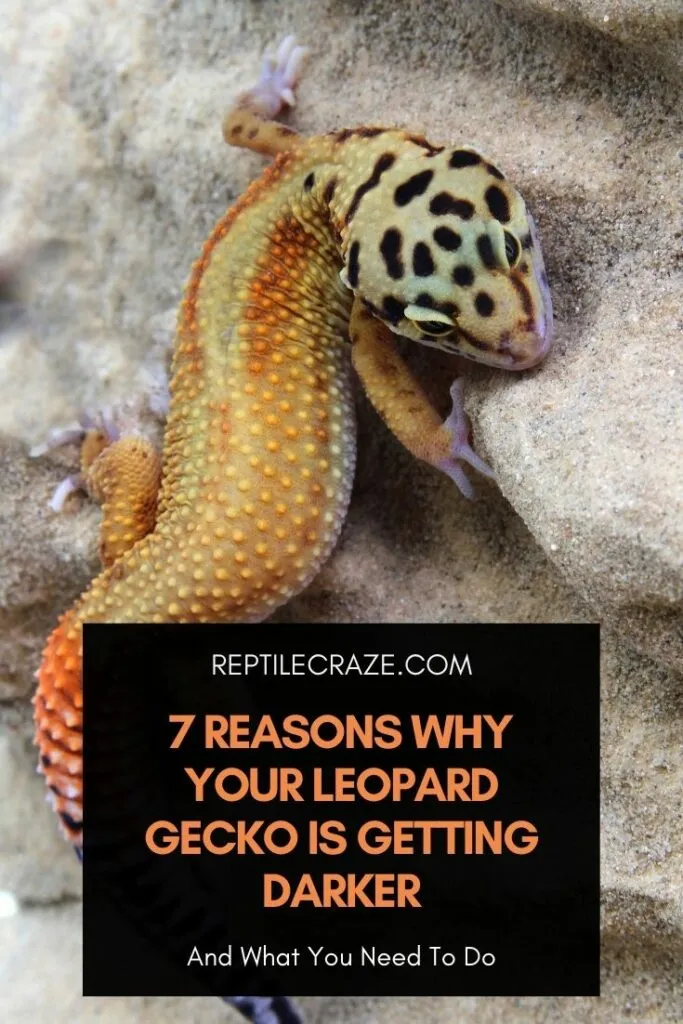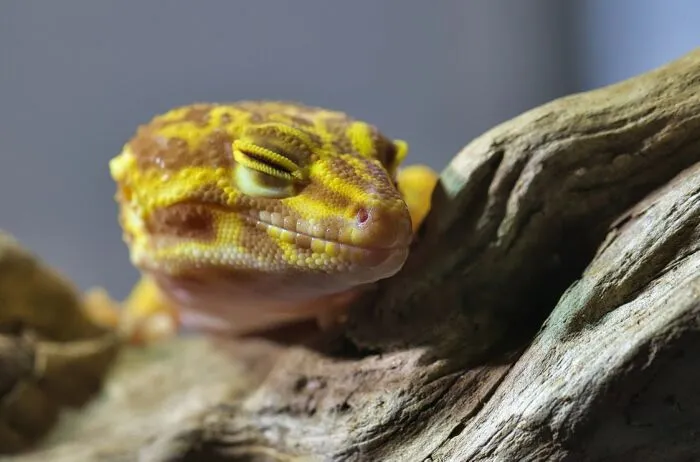
Leopard geckos don’t change colors to blend with their surroundings like chameleons. However, they sometimes do tend to get darker. If your gecko has been doing it, too, here’s why.
The most common reasons for a leopard gecko to get darker are stress, temperature imbalance, and shedding. There could be several other reasons. Checking and correcting the
Usually, your leopard gecko turning darker is not a sign of a major issue. Especially, if it is eating, moving, and pooping, as usual, there is nothing to worry about. But if it is a sign of discomfort for your leo, you should address the problem. In this article, we will explore the different reasons why your leo could be getting darker.
Table of Contents
Different Reasons a Leopard Gecko Can Get Darker
If you are confused or even worried over your gecko turning a shade or two darker, it could be because of the following reasons. Usually, observing the gecko carefully can help you identify the reason.
1. The Surrounding Temperature is Low
Leopard geckos, like other reptiles, use their environment to regulate their body temperature. Thus, they need a thermal gradient inside their terrarium to have a cool zone and a warm zone.
If they feel cold, leopard geckos can turn darker. This helps them absorb more heat from their surroundings. It could be because of temperature imbalance inside the terrarium or it could be because they are outside and cannot find the warmth they need.
If you have a pet leo, you likely have a created a basking zone inside their

So, the temperature of the bottom surface of the
If the thermometer shows a lower temperature near the basking zone, you need to fix this. With the heat source, it is best to use a thermostat to regulate the temperature within the
| Zone | Temperature in °C | Temperature in °F |
| Warm End | 28 °C to 32 °C | 83 °F to 90 °F |
| Cool End | 21 °C to 25 °C | 70 °F to 77 °F |
| Basking Zone | 32 °C to 40 °C | 90 °F to 104 °F |
2. Your Leopard Gecko is Shedding
There is no fixed schedule for a leopard gecko’s shedding. They shed several times during a year and shed more frequently when they are younger.
Leopard geckos generally turn pale or gray when they are ready to shed. However, some geckos might turn dark brown in color, too. Observe if your gecko is spending more time in its hide. This is usually an indication of it softening its skin to help it shed easily.
If your gecko has just shed but you still see that they are a dark brown or black, look carefully for any skin still attached to its body parts. If you notice your leopard gecko having trouble walking after shedding, that could be another sign that it has a retained shed. Look closely.
Retained shed skin is mostly at the extremities like the end of the limbs or tail or even the head. If the old skin has not completely shed and is still attached to their body parts, it could cause restricted blood flow. This needs quick attention and should be handled very carefully.
You can let your gecko soak in some lukewarm water for a while. This will help soften the attached skin. You can gently pull it apart using a pair of tweezers. You can also use a Q-tip or use your hands to gently remove the skin. Never pull at the sheds too hard.
This can pull at the new skin and injure your leo. If the sheds don’t come off easily, let the leo soak in the lukewarm water again. If you are still not able to remove the sheds, it is best to consult a vet.
You can also consult an online vet. They can show you what to do to help your leopard gecko at home. We recommend booking an online at Vetster since they offer 24/7 appointments at an affordable rate. Check them out here!
Here’s a helpful video that shows how you can remove the retained sheds from your pet leo.
A few days after shedding, your gecko will come back to its original shade. If this doesn’t happen, you should look for other reasons or consult a vet.
3. Your Leopard Gecko is Growing Up
As a baby leopard gecko grows, it develops the spots, true to its name. As this happens, some darkening of the skin is expected. If your leo is about a year old, this could well be the reason why you are seeing the change in its skin color.
If your leopard gecko has bands and is turning darker, don’t worry. It is just growing up! Also, some species of leopard geckos have darker coloration once they are fully grown.
If your pet leo still has dark bands around its body, this means it is juvenile. Thus, any darkening could just be the result of aging. Here is a timelapse video of a hypo tangerine growing up. You can see how the skin darkens.
4. The Leopard Gecko is Stressed Out
If your little friend is stressed, it can sometimes respond by darkening. Below are some of the reasons for stress in leos.
- The surrounding temperature is too high.
- The surrounding temperature is too low.
- There has been a change in the leopard gecko’s diet (read our leo diet guide here if you need some help).
- The vivarium size is small.
- The leo is handled too much for its liking.
We discussed here how low temperatures in the warm zone can cause the leo to darken. However, they can also get stressed if the temperature in the cool end zone is higher.
A temperature gradient needs to be created by placing a heating mat under the
If you notice that your leo darkens after too much handling or if someone new handles it, reduce the handling. Any sudden changes in the diet of the gecko can also cause stress.
Even significant changes in the feeding schedule can cause issues. The best way to deal with this is to stick to a set schedule for feeding. If you want to introduce new foods, do so gradually.
5. Nutritional Deficiencies are Causing the Darkening
Nutritional deficiencies can also cause skin darkening in leopard geckos. They need calcium, vitamin D3, and other vitamins. Calcium deficiency can manifest into the darkening of the skin color. If you notice this, you should immediately address this.
Leopard geckos take vitamin D3 through the UV light that you put in their
For heating, it is recommended to use a heating mat under the vivarium or a heat bulb on the top. To include vitamin D3, multivitamins, and calcium in their diet, you need to feed them gut-loaded feeder insects dusted in supplements.
Calcium powder should be placed in the
Many calcium powders available in the market come with appropriate overages of multivitamins. Hence, look at the ingredients so as to not overload your pet leo with supplements.
If you provide the calcium powder, it is very unlikely that the leopard gecko will have more calcium than its body needs. The geckos usually know how much they need.
6. The Substrate in the Tank is Causing Skin Darkening
Sometimes the substrate (floor covering) in the
Loose sand or pebbles can not only cause darkening, but it can also cause impaction and abrasions on your pet gecko’s skin. Even if you are using coco fibers, you need to ensure that it is sprayed with water regularly. However, that tends to increase the humidity in the
In general, avoid using artificial substrates. Instead a mixture of soil and sand, or reptile sand is a better option. Construction sand needs to be avoided since it is quite rough and can cause impaction. You can also use slate pieces or flat stones as substrates.
Even kitchen rolls and tissue papers can be a good option as a substrate. Here’s some helpful information on substrates and cleaning the
7. Overexposure to UV is to blame for the Darkening
Many people use a UVA+UVB lamp as a heat source for pet leopard geckos. However, leopard geckos do not bask (here is why) like bearded dragons, for example.
So, a UV lamp is not absolutely necessary for its well-being. A heating pad under the
But all said and done, too much UV exposure can also cause skin darkening in leopard geckos. This is especially true for certain morphs with reduced melanins such as albinos.
Hence, it is best to limit the use of a UV lamp. If you use a UV lamp, you might want to reduce the exposure by creating a balance between using a heating mat and the lamp.
Another way to protect your leopard gecko from overexposure to UV light is to provide them with enough hiding spaces inside the
- Enchi Ball Python: A Unique and Stunning Morph of Python regius - March 27, 2025
- Emerald Tree Monitor: The Enigmatic Green Guardian of the Rainforest - March 26, 2025
- The Egyptian Cobra (Naja haje): A Fascinating Serpent - March 25, 2025
